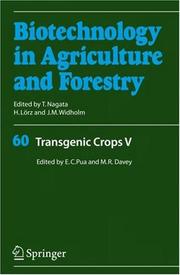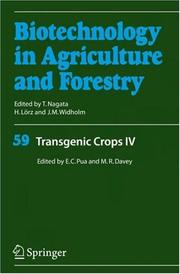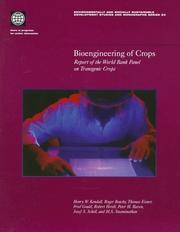| Listing 1 - 10 of 58 | << page >> |
Sort by
|

ISBN: 1281045276 9786611045272 3540491619 3540491600 Year: 2007 Publisher: Berlin, Heidelberg : Springer-Verlag,
Abstract | Keywords | Export | Availability | Bookmark
 Loading...
Loading...Choose an application
- Reference Manager
- EndNote
- RefWorks (Direct export to RefWorks)
Genetic engineering is a powerful tool for crop improvement. The status of crop biotechnology before 2001 was reviewed in Transgenic Crops I-III, but recent advances in plant cell and molecular biology have prompted the need for new volumes. Following Transgenic Crops IV (2007) dealing with cereals, vegetables, root crops, herbs and spices, this volume, Transgenic Crops V, is devoted to fruit, trees and beverage crops. Fruit crops targeted include banana, citrus, mango, papaya, pineapple, watermelon, avocado, grape, melon, apple, Prunus spp., strawberry, and kiwifruit, while trees include walnut, rubber, eucalyptus, tropical tree legumes, Casuarina glauca and conifers. The section on beverage crops reports studies on coffee, cacao, tea, and sugarcane. This volume is an invaluable reference for plant breeders, researchers and graduate students in the fields of plant biotechnology, agronomy, horticulture, forestry, genetics, and both plant cell and molecular biology.
Transgenic plants. --- Biotechnology. --- Chemical engineering --- Genetic engineering --- GE crops (Genetically engineered crops) --- GE plants (Genetically engineered plants) --- Genetically engineered crops --- Genetically engineered plants --- Genetically modified crops --- Genetically modified plants --- GM crops (Genetically modified crops) --- GM plants (Genetically modified plants) --- Novel crops --- Transgenic crops --- Plants, Cultivated --- Transgenic organisms --- Plant genetic engineering

ISBN: 128086396X 9786610863969 3540367527 3540367519 Year: 2007 Publisher: Berlin ; New York : Springer,
Abstract | Keywords | Export | Availability | Bookmark
 Loading...
Loading...Choose an application
- Reference Manager
- EndNote
- RefWorks (Direct export to RefWorks)
Genetic engineering is a powerful tool for crop improvement. Crop biotechnology before 2001 was reviewed in Transgenic Crops I-III, but recent advances in plant cell and molecular biology have prompted the need for new volumes. Transgenic Crops IV deals with cereals, vegetables, root crops, herbs and spices. Section I is an introductory chapter on the impact of plant biotechnology in agriculture. Section II focuses on cereals (rice, wheat, maize, rye, pearl millet, barley, oats), while Section III is directed to vegetable crops (tomato, cucumber, eggplant, lettuce, chickpea, common beans and cowpeas, carrot, radish). Root crops (potato, cassava, sweet potato, sugar beet) are included in Section IV, with herbs and spices (sweet and hot peppers, onion, garlic and related species, mint) in Section V. This volume is an invaluable reference for plant breeders, researchers and graduate students in the fields of plant biotechnology, agronomy, horticulture, genetics and both plant cell and molecular biology.
Transgenic plants. --- Crops --- Genetic engineering. --- Plant genetic engineering --- GE crops (Genetically engineered crops) --- GE plants (Genetically engineered plants) --- Genetically engineered crops --- Genetically engineered plants --- Genetically modified crops --- Genetically modified plants --- GM crops (Genetically modified crops) --- GM plants (Genetically modified plants) --- Novel crops --- Transgenic crops --- Plants, Cultivated --- Transgenic organisms
Book
ISBN: 9086868452 9086863027 9789086863020 9789086868452 Year: 2017 Publisher: Leiden ;Boston Brill | Wageningen Academic
Abstract | Keywords | Export | Availability | Bookmark
 Loading...
Loading...Choose an application
- Reference Manager
- EndNote
- RefWorks (Direct export to RefWorks)
Aware of the significant potential of nascent biotechnologies, the European Economic Community (the predecessor to the European Union) was one of the first regions in the world to develop a regulatory framework for them. Back in the 1980s, the objective of Community member countries was to strengthen the standards of consensus and collaboration, and of environmental and health safety, as well as to promote an industrial sector of enormous potential. In spite of all effort, towards the end of the 1990s it was a widely accepted fact that a number of political and economic factors were blocking the development of biotechnology in Europe. From that crisis emerged what in some aspects is probably the most comprehensive and rigorous body of regulations for biotechnology in the world today. However, the very high technical level of those regulations did not prevent a new crisis which EU institutions aim to solve with a new regulatory framework. Thus, since March 2015, the way towards the third regulatory framework for Biotechnology in the EU has been open. Will this third regulatory framework finally offer sufficient guarantees to allow a healthy and sustainable development of biotechnology in the EU? What do we need to do so that 'third time is lucky'? In this work, a group of European and non-European experts, from different disciplines and approaches, discuss the past and the present, as well as the various possible futures, of Genetically Modified Crops in the EU
Biotechnology --- Transgenic plants --- Law and legislation --- GE crops (Genetically engineered crops) --- GE plants (Genetically engineered plants) --- Genetically engineered crops --- Genetically engineered plants --- Genetically modified crops --- Genetically modified plants --- GM crops (Genetically modified crops) --- GM plants (Genetically modified plants) --- Novel crops --- Transgenic crops --- Plants, Cultivated --- Transgenic organisms --- Plant genetic engineering --- Chemical engineering --- Genetic engineering
Book
ISBN: 9780128104408 0128104406 0128104392 9780128104392 Year: 2018 Publisher: London, England : Academic Press,
Abstract | Keywords | Export | Availability | Bookmark
 Loading...
Loading...Choose an application
- Reference Manager
- EndNote
- RefWorks (Direct export to RefWorks)
Genetic Engineering of Horticultural Crops provides key insights into commercialized crops, their improved productivity, disease and pest resistance, and enhanced nutritional or medicinal benefits. It includes insights into key technologies, such as marker traits identification and genetic traits transfer for increased productivity, examining the latest transgenic advances in a variety of crops and providing foundational information that can be applied to new areas of study. As modern biotechnology has helped to increase crop productivity by introducing novel gene(s) with high quality disease resistance and increased drought tolerance, this is an ideal resource for researchers and industry professionals. Provides examples of current technologies and methodologies, addressing abiotic and biotic stresses, pest resistance and yield improvement. Presents protocols on plant genetic engineering in a variety of wide-use cropsIncludes biosafety rule regulation of genetically modified crops in the USA and third world countries.
Crops --- Plants, Cultivated --- Transgenic plants. --- Plant biotechnology. --- Genetic engineering. --- Genetics. --- Crop biotechnology --- Plants --- Agricultural biotechnology --- GE crops (Genetically engineered crops) --- GE plants (Genetically engineered plants) --- Genetically engineered crops --- Genetically engineered plants --- Genetically modified crops --- Genetically modified plants --- GM crops (Genetically modified crops) --- GM plants (Genetically modified plants) --- Novel crops --- Transgenic crops --- Transgenic organisms --- Plant genetic engineering --- Plant genetics --- Biotechnology
Book
ISBN: 012818633X 0128186321 9780128186336 9780128186329 Year: 2020 Publisher: London Academic Press
Abstract | Keywords | Export | Availability | Bookmark
 Loading...
Loading...Choose an application
- Reference Manager
- EndNote
- RefWorks (Direct export to RefWorks)
"Transgenic Technology Based Value Addition in Plant Biotechnology discusses the principles, methodology and applications of transgenic technologies. With step-by-step methods on genome editing techniques and a range of potential applications, from improving crop yield to increasing therapeutic efficacy, this book is a one-stop reference for plant gene editing technologies. It will be of particular interest to researchers interested in plant biotechnology and plant genetics, as well as agricultural scientists and those concerned with medicinal plants"--
Transgenic plants. --- Plant biotechnology. --- GE crops (Genetically engineered crops) --- GE plants (Genetically engineered plants) --- Genetically engineered crops --- Genetically engineered plants --- Genetically modified crops --- Genetically modified plants --- GM crops (Genetically modified crops) --- GM plants (Genetically modified plants) --- Novel crops --- Transgenic crops --- Plants, Cultivated --- Transgenic organisms --- Plant genetic engineering
Book
ISBN: 0128185643 012822648X 9780128226483 9780128185643 Year: 2021 Publisher: London, United Kingdom Academic Press
Abstract | Keywords | Export | Availability | Bookmark
 Loading...
Loading...Choose an application
- Reference Manager
- EndNote
- RefWorks (Direct export to RefWorks)
"Genetically Modified Plants, Second Edition, provides an updated roadmap and science-based methodology for assessing the safety of genetic modification technologies, as well as risk assessment approaches from regulators across different agroecosystems. This new edition also includes expanded coverage of technologies used in plant improvement, such as RNA-dependent DNA methylation, reverse breeding, agroinfiltration, and gene-editing technologies such as CRISPR and TALENS. This book is an essential resource for anyone interested in crop improvement, including students and researchers, practitioners in regulatory agencies, and policymakers involved in plant biotechnology risk assessment"--
Transgenic plants. --- GE crops (Genetically engineered crops) --- GE plants (Genetically engineered plants) --- Genetically engineered crops --- Genetically engineered plants --- Genetically modified crops --- Genetically modified plants --- GM crops (Genetically modified crops) --- GM plants (Genetically modified plants) --- Novel crops --- Transgenic crops --- Plants, Cultivated --- Transgenic organisms --- Plant genetic engineering
Book
ISBN: 9535152297 9535101811 Year: 2012 Publisher: IntechOpen
Abstract | Keywords | Export | Availability | Bookmark
 Loading...
Loading...Choose an application
- Reference Manager
- EndNote
- RefWorks (Direct export to RefWorks)
Development of efficient transformation protocols is becoming a complementary strategy to conventional breeding techniques for the improvement of crops. Thus, Transgenic Plants - Advances and Limitations covers the recent advances carried on improvement of transformation methods together with assessment of the impact of genetically transformed crops on biosafety. Each chapter has been written by one or more experienced researchers in the field and then carefully edited to ensure throughness and consistency.
Transgenic plants. --- GE crops (Genetically engineered crops) --- GE plants (Genetically engineered plants) --- Genetically engineered crops --- Genetically engineered plants --- Genetically modified crops --- Genetically modified plants --- GM crops (Genetically modified crops) --- GM plants (Genetically modified plants) --- Novel crops --- Transgenic crops --- Plants, Cultivated --- Transgenic organisms --- Plant genetic engineering --- Meteorology & climatology
Book
ISBN: 9780813803494 Year: 2013 Publisher: Ames, Iowa : Wiley-Blackwell,
Abstract | Keywords | Export | Availability | Bookmark
 Loading...
Loading...Choose an application
- Reference Manager
- EndNote
- RefWorks (Direct export to RefWorks)
Transgenic plants --- Plant genetic transformation --- Plantes transgéniques --- Prevention --- GE crops (Genetically engineered crops) --- GE plants (Genetically engineered plants) --- Genetically engineered crops --- Genetically engineered plants --- Genetically modified crops --- Genetically modified plants --- GM crops (Genetically modified crops) --- GM plants (Genetically modified plants) --- Novel crops --- Transgenic crops --- Plants, Cultivated --- Transgenic organisms --- Plant genetic engineering --- Plant transformation --- Genetic transformation

ISBN: 0821340735 Year: 1997 Publisher: Washington, D.C. World Bank
Abstract | Keywords | Export | Availability | Bookmark
 Loading...
Loading...Choose an application
- Reference Manager
- EndNote
- RefWorks (Direct export to RefWorks)
Crops --- Plant genetic engineering --- Transgenic plants --- GE crops (Genetically engineered crops) --- GE plants (Genetically engineered plants) --- Genetically engineered crops --- Genetically engineered plants --- Genetically modified crops --- Genetically modified plants --- GM crops (Genetically modified crops) --- GM plants (Genetically modified plants) --- Novel crops --- Transgenic crops --- Plants, Cultivated --- Transgenic organisms --- Plants --- Genetic engineering --- Plant biotechnology --- Soil biology
Book
ISBN: 1283154846 9786613154842 064309461X 9780643094611 9781283154840 0643091602 9780643091603 6613154849 0643098976 9780643098978 Year: 2006 Publisher: Collingwood, Vic. CSIRO Pub.
Abstract | Keywords | Export | Availability | Bookmark
 Loading...
Loading...Choose an application
- Reference Manager
- EndNote
- RefWorks (Direct export to RefWorks)
A balanced, scientific perspective on the issues surrounding genetically modified crops.
Crops --- Transgenic plants. --- GE crops (Genetically engineered crops) --- GE plants (Genetically engineered plants) --- Genetically engineered crops --- Genetically engineered plants --- Genetically modified crops --- Genetically modified plants --- GM crops (Genetically modified crops) --- GM plants (Genetically modified plants) --- Novel crops --- Transgenic crops --- Plants, Cultivated --- Transgenic organisms --- Plant genetic engineering --- Genetic engineering.
| Listing 1 - 10 of 58 | << page >> |
Sort by
|

 Search
Search Feedback
Feedback About UniCat
About UniCat  Help
Help News
News